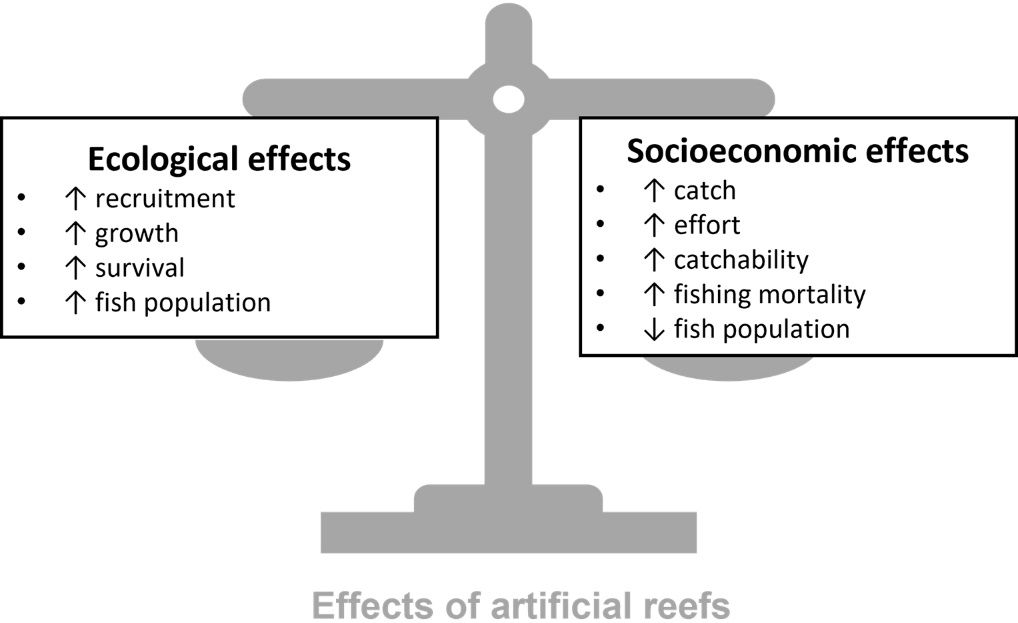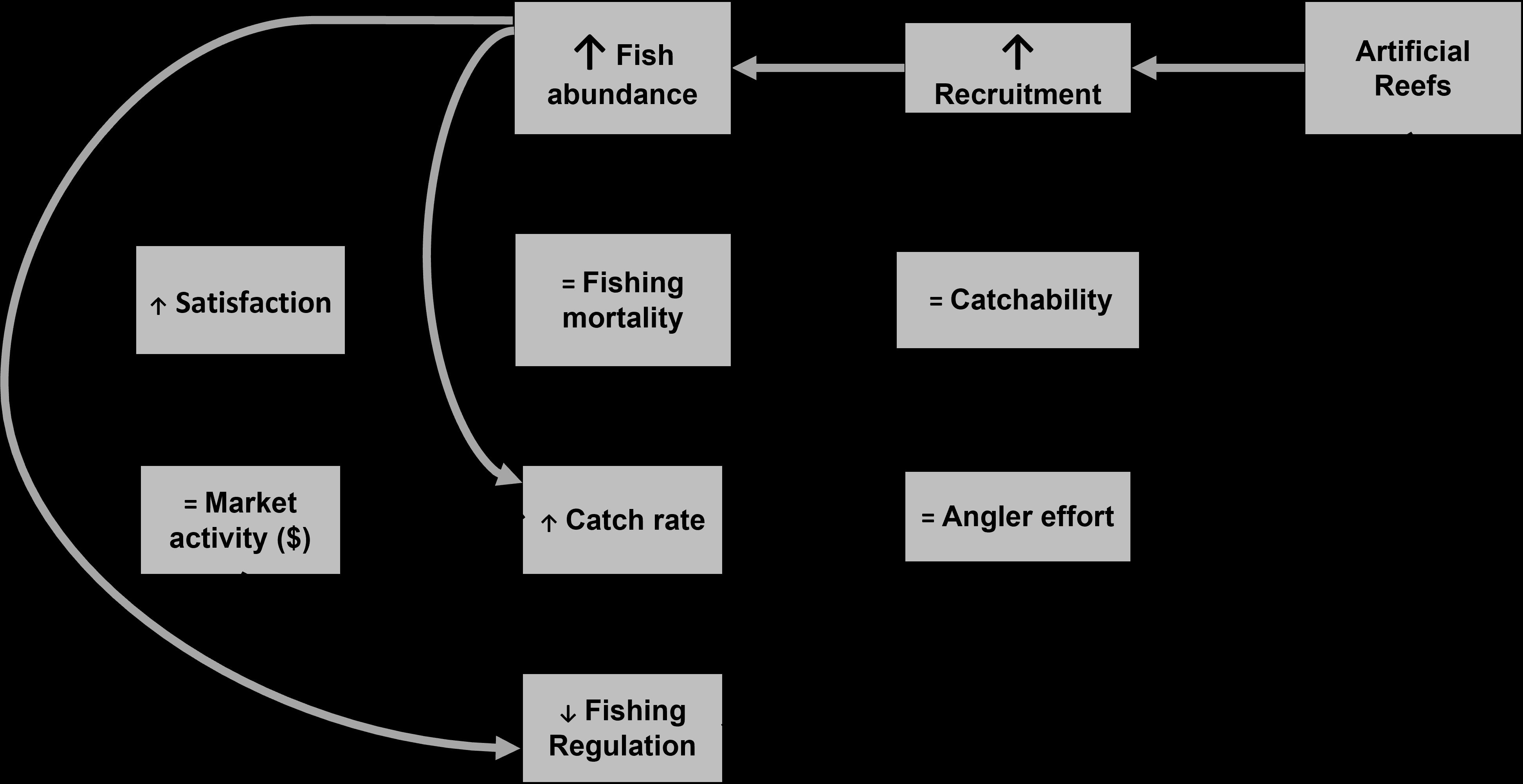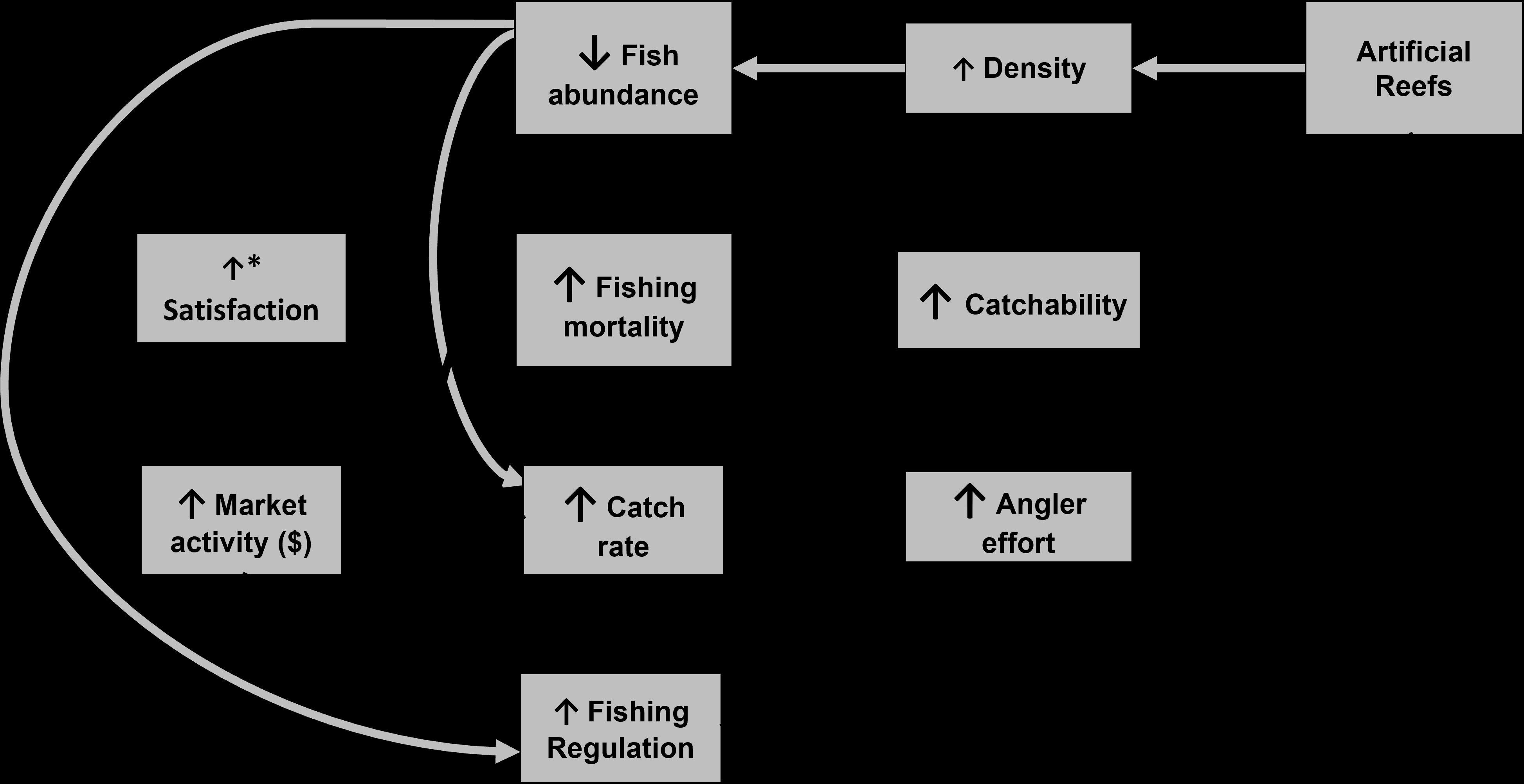Artificial Reefs in Florida 101—why is this publication important?
Coastal managers and practitioners increasingly place artificial reefs in marine waters. Artificial reefs are expensive to deploy, but they are much more expensive to remove. This makes them relatively permanent habitat alterations. These long-lasting habitat alterations have measurable effects on fish, fishers, divers, fisheries, and the overall marine ecosystem and connected human socioeconomic system. It is critical to understand how artificial reefs “work” to make good decisions about future artificial reefs. While scientists have researched many aspects of artificial reefs, this information is not always summarized and explained to the public. To address this need we designed a 4-part series called Artificial Reefs 101:
- Part 1 describes why artificial reefs are built.
- Part 2 describes how artificial reefs affect fish ecology.
- Part 3 describes how artificial reefs affect users, mostly focusing on fishers.
- Part 4 describes how the overall fishery system (both fish and fishers) is affected by artificial reefs.
The Artificial Reefs 101 series is intended to provide a general overview for users seeking to better understand artificial reefs in Florida. It also gives some additional details and references for those wishing to dive deeper into the science. The Artificial Reefs 101 series compliments existing publications about specific aspects of artificial reefs, such as how they are implemented (FA231), the ecological effects of artificial reefs on fish (SG100), and the economic benefits of artificial reefs (FE649). There is additional information available through the Florida Master Naturalist Program in the Marine Habitat Restoration Course.
This specific publication describes ways artificial reefs affect fisheries and recreational diving systems. It builds off information provided in the earlier three publications. The first publication describes how reefs are often deployed to improve fisheries. The second publication shows if artificial reefs had no positive effects on fishers (e.g. increased fishing) and did not result in an ecological trap, artificial reefs should help fish populations at least a little. However, the third publication shows it is likely artificial reefs will also affect fishers. This will translate to greater catchability and fishing effort, and thus harvest rate. Without any increase in actual population productivity, a greater harvest rate will lead to fish population decline. These effects set up the most fascinating dynamics of artificial reefs: will their ecological, likely positive, effects on fish populations be able to outweigh their socioeconomic, likely negative, effects on fish populations? This publication explores more about this looming trade-off and the variables that might affect it. This publication should help the interested public understand more about the social, ecological, and economic effects of artificial reefs as well as providing a background and baseline of information to decision makers like local officials, management agency personnel, and Extension agents.
Total Effects of Artificial Reefs On Fisheries
If we think artificial reefs only affect fish populations, without considering any impacts to fishers or fishing, then we should expect the artificial reefs to increase fish populations by decreasing natural mortality and/or increasing recruitment or growth. (This is described and explained in greater detail in the second in the Artificial Reefs 101 series, Effects on Fish.) This means that artificial reefs are attracting fish and supplying space for sheltering and foraging, which increases population size. Alternatively, if we think about artificial reefs only affecting fishers and fishing without considering how they could positively change fish populations ecologically, we should expect increases in catchability and fishing effort at artificial reefs. Catchability would increase because artificial reefs would help fishers more quickly find and catch fish, leading to greater catch rates, at least initially. Greater catch rates would lead to more fishing effort, though added effort might also exist if anglers simply prefer fishing artificial reefs to fishing in natural areas. For example, anglers may prefer fishing artificial reefs when targeting certain species like amberjack, cobia, or gag grouper that are drawn to these structures. Greater catch rates and effort could also mean greater fisher satisfaction, as well as a greater positive economic impact and contribution. But these benefits might be temporary, because if the reefs are allowing much greater harvest, fish populations will eventually decline. These effects are described and explained in greater detail in the third artificial reefs 101 publication, Effects on Fishers.
When we look at the system together, we need to include effects on both fish and fishers, and how they affect each other. Ecological effects should cause fish populations to increase a little, or at least aggregate around artificial reefs. But in many cases fishing effort and catchability would also likely increase because more people would be able to find good fishing areas, since typically the locations of these reefs are published and made available to the public. Together, the potentially greater number of fish aggregated around known fishing locations could lead to greater catchability and even effort (Camp, Ahrens, Allen, and Lorenzen 2016; Karnauskas, Walter, Campbell, et al. 2017). This would lead to increased fishing mortality. If the greater harvest is not offset by greater increases in ecological productivity from artificial reefs, the fish populations would decline. If fish populations were to decline too much, managers would have to make regulations to reduce harvest and help fish repopulate to sustainable levels. What we will end up with is a balancing act. The total effect of artificial reefs depends on whether the reefs’ biological and ecological effects on fish cause a population increase (one side of the balance) that is greater than or at least equal to the increase in fishing mortality (the other side of the balance) from the reefs’ combined socioeconomic effects, namely increased catchability and effort (Figure 1). This balance is difficult to predict because all the rates affecting fish, fishers, and fishery (e.g., growth, mortality, effort, catchability) are difficult to measure and vary depending on a variety of factors (e.g., reef type, location, age, fish species, etc.). Probably the most important point of this publication is that we should not assume artificial reefs will have a positive effect on fish populations.

Credit: Lisa Chong, UF/IFAS
Examples of the Potential Outcomes of Artificial Reefs
Fishery outcomes of artificial reefs are likely to depend on a few key factors, such as how sustainable the fish populations are and the level of fishing mortality. This means it is hard to predict, in general, how artificial reefs could affect fisheries or diving systems. To illustrate this, we provide detailed examples of how artificial reefs might affect the overall fishery, below. It is important to understand that these examples are not all equally likely—for example, the first and third cases would probably be rare.
(1) Artificial reefs serve as fish habitat but not good fishing spots and would increase fish populations (Figure 2).
If artificial reefs function as important habitat for fish using them during recruitment or other important life history stages, we would expect the fish population to increase if fishing mortality and harvest does not also go up. This situation might happen if artificial reefs are located where fishing is not allowed or where it is uncommon. Other possibilities might include, fishers never find deployed artificial reefs or if reefs are used by fish that are not commonly targeted, are difficult to catch, or are located in an area where fishing is uncommon or not allowed. A related scenario would be if artificial reefs function as decent fishing spots but just increase fish populations more than they increase harvest (i.e., they are good for increasing fish populations, and only a little good at increasing fish harvest). Both cases would see artificial reefs being good for fish populations, but not especially great for socioeconomic metrics like fisher satisfaction and economic activity. This scenario does not seem likely to occur unless the artificial reefs are placed in marine protected areas not allowing recreational fishing.

Credit: Lisa Chong, UF/IFAS
(2) Artificial reefs increase fishing harvest as fishing enhancements.
Despite their popularity and assumed ecological benefits, there are circumstances where artificial reefs could cause fish populations to decline, possibly leading to limits on fishing seasons. This situation could happen if some or all the following occur (Figure 3):
- Artificial reefs attract fish from other areas without dramatically increasing their overall populations.
- Fish gather in greater densities on artificial reefs than in other natural locations.
- Artificial reef locations are made public or commonly known by fishers.
- Fishing is easier at artificial reefs than other locations because they are large structures easily found by bottom machine. The congregation of boats also draws the attention of other boats.
- Artificial reefs increase the overall fishing effort.
If artificial reefs both attract fish at high rates (numbers 1 or 2) and provide easier or more fishing opportunities (numbers 3, 4, or 5), then artificial reefs increase fishing mortality. This effect happens if artificial reefs gather or attract fish in known and easily accessible areas. Fishers would spend less time looking for fish and encounter more fish within a given amount of time. Fishers will more likely keep using these artificial reefs if catch rates are high. Together, these changes can result in increased catch rates, harvest, and fishing mortality (Bohnsack and Sutherland 1985; Lindberg 1997; Karnauskas, Walter, Campbell, et al. 2017). It is important to understand these effects could happen even if there are positive ecological effects of artificial reefs—if the effects on catchability and/or effort outpace those ecological improvements.

Credit: Lisa Chong, UF/IFAS
Greater fishing mortality is not always bad. If a species of fish is not near any overfishing limit, a greater fishing mortality rate means more fish are being used by humans (though there can sometimes be ecosystem effects). The problem occurs when the fish species is already near overfishing limits <https://edis.ifas.ufl.edu/publication/FA232>. Many recreationally important reef fish species are likely to be overfished because of their life history. Most reef fishes have a long life span and slow growth rate. When they are overfished, it is more difficult for them to rebuild biomass than a species that does not live very long and grows fast. Hermaphroditic species like grouper that are commonly caught at artificial reefs may also cause management challenges because of the alteration of sex ratios caused by targeting larger fish or overfishing. Reef fishes also have high site fidelity and tend to concentrate over specific types of habitats, making them easier to find and catch. If these species continue to reach overfishing limits, the added fishing mortality may lead to stricter regulations. These restrictions could be greater minimum size limits, implementing “slot” or harvest window length limits, smaller bag limits, or even shorter harvest seasons. Shorter seasons especially are unpopular with fishers and could negatively affect the local economy, especially in the short term. It seems likely from recent literature the potential increases in catchability may greatly outpace any ecological benefits artificial reefs could provide fish (Karnauskas, Walter, Campbell, et al. 2017), and so at least part of this scenario seems more likely to occur.
(3) Artificial reefs increase fish and improve fishing
Lastly, there could be a scenario where artificial reefs can help (or at least not harm) fish populations and provide fishers with more fish to catch. This can only happen under two scenarios:
- Artificial reefs benefit fish ecologically (increased recruitment or survival) as much or more than they increase fishing mortality. For example, if artificial reefs could increase fish populations (e.g., by increasing recruitment) 7%, while only increasing fishing mortality 5%.
- Artificial reefs increase fishing mortality more than they increase fish populations, but not to the extent fish populations are badly affected, and recruitment overfished. In theory, if white grunt populations were estimated to be only lightly harvested, an increase in fishing mortality rate would not especially damage the population or cause it to have low recruitment or a low spawning potential ratio (See Camp, Collins, Ahrens, and Lorenzen 2020 and 2021).
Deploying artificial reefs fitting these scenarios might include placing artificial reefs in shallower water to attract smaller, less commonly targeted reef species like grunts. Species that inhabit deeper waters like red snapper and larger groupers are not ideal because they are near overfishing thresholds and currently have limited harvest seasons. This third scenario is not impossible, but it becomes less likely as more and more species using reefs seem to approach overfishing thresholds (e.g., there has been concern and recent management changes for sheepshead and flounder). Managers will need to consider all the possible situations when installing artificial reefs at a specific location. They will need to think about types of reefs, material, distance from shore or other reefs, and the purpose of the deployment. There is a lack of reports and examples quantifying reef placement impacts (Bortone, Brandini, Fabi, and Otake 2011). This lack of information makes it difficult for scientists and managers to come up with good placement plans and inhibits our ability to predict effects.
Total effects of artificial reefs on recreational diving systems
The biological benefits of artificial reefs for recreational diving systems should be like recreational fishing systems. Fish populations will increase if artificial reefs help decrease natural mortality and increase growth and/or recruitment. The major difference between recreational diving systems and fishing systems is how humans use the artificial reefs. For this discussion, we group spear divers with fishers. Divers who are non-harvesters should not have negative effects on fish. They may even have positive effects such as removing ghost fishing gear and targeting lionfish. Fish populations would then likely increase, and divers would be happy seeing more marine life. The overall recreational diving system would be enhanced by more artificial reefs. However, if artificial reef dive trips are not properly promoted or divers are just not interested in the artificial reefs that are implemented, they may lose value and tourist activity (Oliveira, Ramos, and Santos 2015). User conflicts also may rise if fishing and diving activities are not properly distributed and the fisheries overharvest fish. In short, recreational diving systems should allow biological benefits for fish populations and bring socioeconomic benefits through tourism.
Conclusion
There are many possible outcomes from artificial reef implementation as outlined in this publication. Artificial reefs affect fish and people in many ways and intensities, which makes it difficult to predict and measure the impacts of reef deployment. Sometimes the sum of these changes is not what we would think. It is not responsible to assume that artificial reefs will either “improve” or “hurt” a fishery without this information. However, based on the current literature and knowledge, it seems artificial reefs will most likely result in greater fishing harvest. Scientists are increasingly concerned that some artificial reefs may eventually lead to greater fishing mortality, which for some species would mean shorter harvest seasons and stricter regulations. Therefore, it is important to understand how fishers and fish interact with artificial reefs to determine their impact on a specific fishery.
This series provides baseline information on artificial reefs to the public and to decision makers like local officials, management agency personnel, and Extension agents. In the earlier publications of this series, we describe reasons why artificial reefs are built and the effects of artificial reefs on fish and fishers. Together, this series should help readers understand why we need to consider who is affected by artificial reefs and how their interaction then results in certain outcomes, either positive or negative ones. Understanding fisher and fish interactions with reefs can also aid in finding ideal locations to place future artificial reefs and provide strategies to improve management of these fisheries.
More information about artificial reefs
To learn more about artificial reefs, the following external links and EDIS publications are listed below:
- National Artificial Reef Plan (as amended 2007): https://www.bsee.gov/sites/bsee.gov/files/research-other/narpwcover3.pdf
- State of Florida Artificial Reef Strategic Plan: https://www.mbara.org/pdf/Florida%20Artificial%20Reef%20Strategic%20Plan.pdf
- The process of artificial reef implementation in Florida: https://edis.ifas.ufl.edu/publication/FA231
- Economic benefits of artificial reefs: https://edis.ifas.ufl.edu/fe649
- Economic impacts of specific counties: Manatee, Sarasota, Hillsborough, Pinellas, Charlotte, Lee, Southwest region; https://edis.ifas.ufl.edu/entity/topic/artificial_reefs
- Ecology of artificial reefs: https://edis.ifas.ufl.edu/sg100
To contact for more information:
- Florida Fish and Wildlife Conservation Commission (FWC): https://myfwc.com/fishing/saltwater/artificial-reefs/
- Florida Sea Grant: https://www.flseagrant.org/
- Florida Department of Environmental Protection (FDEP): https://floridadep.gov/
- United States Army Corps of Engineers (ACE): https://www.usace.army.mil/
References
Bohnsack, J., and D. Sutherland. 1985. “Artificial Reef Research: A Review with Recommendations for Future Priorities.” Bulletin of Marine Science 37:11–39.
Camp, E.V., R. N. M. Ahrens, M. S. Allen, and K. Lorenzen. 2016. “Relationships between Angling Effort and Fish Abundance in Recreational Marine Fisheries.” Fisheries Management and Ecology 23:264–275. https://doi.org/10.1111/fme.12168
Camp, E. V., A. B. Collins, R. N. M. Ahrens, and K. Lorenzen. 2020. “Fish Population Recruitment: What Recruitment Means and Why It Matters.” FA222 EDIS 2020 (2): 6. https://doi.org/10.32473/edis-fa222-2020.
Camp, E. V., A. B. Collins, R. N. M. Ahrens, and K. Lorenzen K. 2021. “Fish Population Recruitment 2: Stock Recruit Relationships and Why They Matter for Stock Assessment: FA234, 09/2021.” EDIS 2021 (5). https://doi.org/10.32473/edis-fa234-2021
Bortone, S. A., F. P. Brandini, G. Fabi, and S. Otake (Eds.). 2011. “Artificial Reefs in Fisheries Management.” CRC Press. https://doi.org/10.1201/b10910
Karnauskas, M., J. F. Walter, M. D. Campbell, A. G. Pollack, J. M. Drymon, and S. Powers. 2017. “Red Snapper Distribution on Natural Habitats and Artificial Structures in the Northern Gulf of Mexico.” Marine and Coastal Fisheries 9:50–67. https://doi.org/10.1080/19425120.2016.1255684
Lindberg, W.J. 1997. “Can science resolve the attraction-production issue?” Fisheries 22:10–13.
Oliveira, M. T., J. Ramos, and M. N. Santos. 2015. “An Approach to the Economic Value of Diving Sites: Artificial Versus Natural Reefs off Sal Island, Cape Verde.” Journal of Applied Ichthyology 3186–95. https://doi.org/10.1111/jai.12953